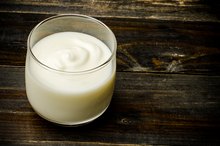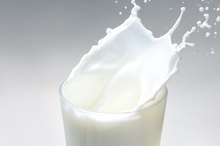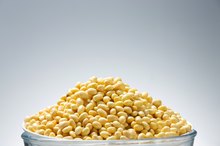Allergic to Whole Milk
Milk is one of the eight common foods that cause 90 percent of allergic reactions, according to the Food Allergy and Anaphylaxis Network. A true allergy to milk is an allergic reaction to one or both of the proteins found in milk: whey and casein. Whey and casein are found in any kind of milk, whole or skim. A true milk allergy causes digestive, respiratory and skin reactions, including itching and hives, and can even lead to anaphylactic shock, a life-threatening allergic reaction.
Intolerance vs. Allergy
If you experience stomach pain, bloating, gas and intestinal distress after drinking whole milk, but don't have respiratory symptoms like a runny nose, coughing or itchy skin and hives, chances are you have lactose intolerance, not a milk allergy. A milk allergy causes a variety of symptoms, including wheezing, runny nose, hives, vomiting and gastrointestinal issues, including diarrhea and nausea. Milk allergy symptoms may be more severe after eating processed foods containing concentrated milk protein like whey or casein than after drinking ordinary whole milk.
Causes
Milk Allergy & Skin Rash
Learn More
If you are allergic to milk, your immune system mounts a response to proteins in milk that it identifies as foreign. Your body releases antibodies that bind to the allergic substance and histamines that produce allergy symptoms. According to the University of Illinois Department of Animal Sciences, there are several types of proteins in milk, including caseins and the proteins found in whey -- beta-lactoglobulin and alpha-lactalbumin. The University of Florida reports, children can be allergic to either caseins, whey protein or both. Whole milk contains curds, whey and all the proteins that can cause an allergic reaction. According to the American Academy of Allergy, Asthma and Immunology, most children outgrow milk allergies, including those with a history of severe reactions.
Symptoms
An allergic reaction to whole milk can occur within a few minutes to several hours after consumption, according to the Food Allergy and Anaphylaxis Network. Hives, itching, flushed face and chest and a rash are skin-based symptoms. Respiratory symptoms include a runny nose, congestion, sneezing and coughing. Digestive symptoms include nausea, vomiting, cramps and diarrhea. If you experience trouble breathing and feel that your throat is swelling, contact a doctor immediately, as this is a sign of the most serious allergic reaction, anaphylactic shock.
Eliminating Dairy
If You Are Allergic to Milk Can You Eat Yogurt
Learn More
If you are truly allergic to milk, which can be determined by a food challenge, a skin prick test and other exams administered by an allergist, your allergy will not be restricted to whole milk. Skim milk, buttermilk, ice cream and yogurt will also cause an allergic reaction. Processed, concentrated milk protein is also found in many commercial foods, including breads, cakes, cookies, snacks and frozen dinners. Avoid processed foods containing whey and casein, and eat lean protein, vegetables, whole grains and fruits that do not contain dairy.
Related Articles
Writer Bio
Amy Sterling Casil is an award-winning writer with a Master of Fine Arts in creative writing from Chapman University in Orange, Calif. She is a professional author and college writing teacher, and has published 20 nonfiction books for schools and libraries.









